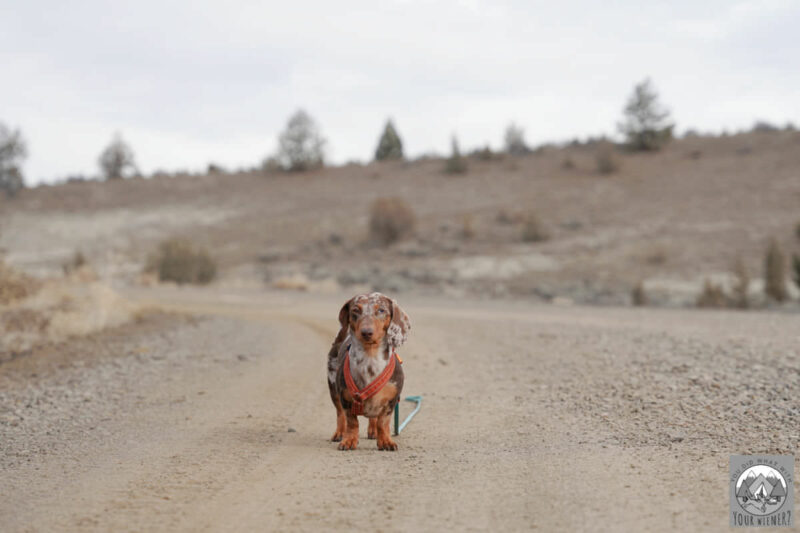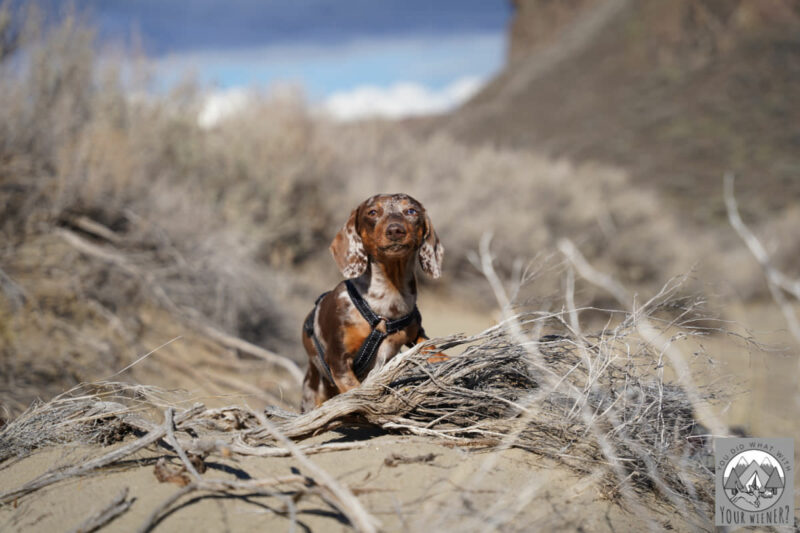Valley Fever in Dogs – What You Need to Know
There are many risks that we may encounter when adventuring outdoors, depending on our location.
From dangerous algae in the waterways to running into a bear in the woods, outdoor adventurers must be prepared.
UPDATED: This article was originally published in July of 2012.



For many located in the western states, or who travel there, the risk of valley fever in dogs is one that you should be aware of.
But what is valley fever, also referred to as ‘canine valley fever’, and how can you keep your dog safe?
In this article, I’m going to share everything you need to know.
What is Valley Fever in Dogs?
Valley fever is a fungal infection that occurs when a dog breathes in the fungi spores from the fungus Coccidioides.
After the dog inhales the spores into their lungs, they grow into spherules.
This is the thick-walled, non-budding form that the fungus will take when it is in tissue. They contain a granule material known as endospores.
The spherules will continue to grow and enlarge until they burst, releasing the endospores to spread the infection further as they take root and grow into new spherules.
In many cases, the immune system can fight off infections in the early stages.
However, if it doesn’t kill the spherules and endospores quickly enough, they will continue to spread through the lungs and even throughout the body.
This is when the illness valley fever occurs.
How Does a Dog Get Valley Fever?
The fungus responsible for valley fever grows in the soil.
It thrives in areas that experience mild winters, hot summers, and low rainfall.
When the soil is disturbed, the microscopic fungal spores are released into the air.
Your dog can get valley fever from inhaling those spores.
That’s right, your dog can get this disease just from BREATHING!
There are many ways that the soil can be stirred up or disturbed enough to release the spores.
This includes outdoor activities like hiking and biking, construction, or even a strong enough wind.
My friend’s dog got it after digging in his Grandmother’s yard in Arizona. It wasn’t even from being out exploring!
Dogs are at high risk of exposure because they tend to play in the dirt.
Whether a dog is digging in the dirt or rolling in it, they are disturbing the soil in the area directly around their faces.
Studies have revealed that Boxers and Golden Retrievers are more likely to be diagnosed with Valley Fever, but they aren’t the only dogs at risk.
Any dog that spends time outdoors in an area with the fungus can be exposed, no matter the breed.
My friend’s dog that I previously mentioned is a Dachshund (who loved to dig).
The good news is that valley fever is not contagious.
If you have multiple dogs, they cannot pass it from dog to dog.
Where Can My Dog Get Valley Fever?
Most dog owners that have heard of Valley Fever connect it with Arizona due to the large number of outbreaks that have been reported in that state.



This is for good reason with approximately 2/3 of the cases in the United States occurring in that area.
But there are many other areas that we should be aware of.
For example, when viewing the CDC’s map of reported cases in the United States, you can see that there is a risk of valley fever in Washington State, where we live.
This led to my interest in learning more about valley fever.
Since moving to the east side of Washington Sate, we are doing more hiking and camping in the desert and I want to know how to protect my dogs.
There are two different types of fungi responsible for Valley fever – Coccidioides immitis and Coccidioides posadasii.
While these two types of fungi thrive in slightly different climates and environmental settings, they can both cause serious illness in both you and your dog.
C. posadasii is commonly located in:
- Arizona
- New Mexico
- Nevada
- Utah
- Texas
- Parts of southern California
C. immitis is primarily found in California as well as in Washington State.
Outside of these areas, the risk is significantly lower. But there are cases of valley fever reported as far away from these areas as New Hampshire, Rhode Island, and Delaware.
For those considering traveling internationally, the fungi are also present in parts of Mexico, Central America, and South America.
Signs of Valley Fever in Dogs
If you have recently spent time in an area where valley fever may have been present and your dog is acting ‘off’, you may be wondering how to tell if your dog is sick.
When my friend told me about his dog, acting ‘off’ he said his dog was lethargic, panting, and clearly not feeling well.
As with many pups that are showing early symptoms of valley fever in dogs, his dog was originally diagnosed with pneumonia.
After further testing, it was discovered that his Dachshund had valley fever.
It is not uncommon for valley fever to be misdiagnosed or undiagnosed.
When you are dealing with valley fever in dogs, symptoms are often shared with many other illnesses, which can make it hard to pinpoint an exact cause.
To diagnose your dog accurately, tests will need to be done by your veterinarian.
The most common valley fever dog symptoms to watch out for include:
- Harsh, dry cough
- Fever
- Loss of appetite
- Weight loss
- Lethargy or low energy
- Depression
If the illness continues to spread outside of the lungs and into other areas of your dog’s body, they may experience:
- Soft abscess-like swelling under the skin
- Skin wounds that ooze fluid and won’t heal
- Swollen lymph nodes under the chin, in front of the shoulder blades, or behind the stifles
- Inflamed, painful joints
- Swollen limbs
- Lameness
- Back or neck pain
- Swollen testicles
- Eye inflammation causing pain, cloudiness, or blindness
- Weakness or paralysis
- Unexpected heart failure in a young dog
When the illness isn’t caught early, it can also trigger secondary illnesses like a lung infection or pneumonia, as it did in the case of my friend’s dog.
In some rare cases, the fungus can spread to the brain causing it to swell.
In these more serious examples of valley fever in dogs, neurological symptoms like seizure activity may be seen.
Is Valley Fever Curable?
If you have come across this article because you were researching the signs of infection listed above, you may be wondering – My dog has valley fever, now what? Is there a cure?
There is currently no cure for valley fever
But there are treatment options to address the symptoms and support the immune system as it fights the fungal infection.
With early diagnosis of valley fever in dogs, the survival rate is high.
Valley Fever Treatment in Dogs
The most common treatment for valley fever in dogs is the use of antifungal medications.
In cases where the fungus is restricted to the lungs, treatment usually lasts 6 to 12 months. However, if the fungus has spread, prolonged treatment may be needed.
If the fungus has reached the nervous system, antifungal medications are often required for the rest of the dog’s life.
The medications that are most prescribed for treatment of valley fever include:
- Fluconazole (Diflucan)
- Itraconazole (Sporanox)
- Ketoconazole (Nizoral)
For dogs that have bone or joint infections, pain medication and anti-inflammatories may also be given to keep your dog comfortable while the antifungal medications work.
Dogs with the most severe cases may need to be hospitalized where they can receive intravenous antifungal medication, supportive therapy, and ongoing supervision.
Serious cases to this extent are not common, but they do happen.
If a dog suffers extensive damage to the lungs from the fungal infection, they may need surgery to remove the diseased lung to give the best chance of survival.
Unfortunately, tests, medications, surgeries, and hospital stays can all come at a high cost. If you have invested in pet insurance for your dog, some of these costs may be covered.
Are There Natural Remedies for Valley Fever in Dogs?
I am not a veterinarian.
While I did investigate natural remedies, I would not recommend a natural treatment or “home remedy” for anything this serious without first consulting with your veterinarian.
While I was unable to find any credible recommendations for natural treatments, I did find some options to SUPPLEMENT traditional treatment.
This includes remedies to address the symptoms during treatment as well as supplements to support and boost the immune system.
CBD oils have been gaining attention and popularity in recent years due to their ability to naturally reduce pain and inflammation. This could be an alternative to pain medications to relieve discomfort.
Other options to address the symptoms may include natural cough suppressants and natural appetite stimulants.
In my research, I did find a Canine “Valley Fever Package” of supplements that includes a natural combination of vitamins, minerals, and antioxidants to boost the immune system and support lung function. These can help to further strengthen traditional treatment.



How Can I Prevent My Dog from Getting Valley Fever?
There is currently no vaccine to protect dogs from valley fever. But there is one under development that could make a big difference for those that regularly spend time in high-risk areas.
I believe that you should be aware of valley fever and take precautions, where it makes sense, but don’t let it stop you and your dog from enjoying life.
Only a small percentage of the pets living in or visiting areas where it is present in the soil will contract valley fever.
But there are steps that you can take to further lower your dog’s risk.
When you are out hiking or exploring with your dog, discourage any digging or sniffing of rodent holes.
While the fungus spores can be stirred up just from walking, the chance of inhaling the fungal spores is much higher with these activities.
They not only involve disturbing the ground but also position your dog’s nose right in the dust as it is stirred up.
Plan your outdoor adventures with the weather in mind. Pay attention to the weather forecast and avoid going outdoors during conditions like dust storms that could increase your risk.
Another other option is to focus on boosting your dog’s overall health and immune system with supplements.
This will help to increase the chances that your dog’s natural line of defense can fight off any potential illness if he is exposed to the spores.
Most importantly, make sure that you are familiar with the signs of valley fever in dogs and contact your veterinarian if you have any reason to be concerned.






About the Author
Hi, I’m Jessica. I’ve been studying the Dachshund breed since 2007, owned 3 of my own, and shared in the lives of thousands of others through their owner’s stories. When I’m not sharing what I know on this blog, you can find me hiking, camping, and traveling with my adventurous wiener dogs.


Valley Fever is controllable with medication. It’s not ideal to get it, but… like everything else, it’s a tradeoff. If you live in the northeast there are ticks and toxic flea and tick medications to prevent them. I walk on dirt trails every day with my dog; so do my friends and other people I see all the time. I’m not saying dogs (and people) don’t get Valley Fever, but it’s not something that we stress about (no more than, say, about rattlesnakes ;-). Come visit! You’ll like it here. In winter, of course.
Thanks Edie. I appreciate having a local perspective. Once you start looking into it you come across all sorts of “alarmist” information so it is hard to get perspective.
I believe Valley Fever is quite common in Arizona (and taken care of with medication)- especially in desert like areas like Arizona. D (who grew up in Tucson) knows about this and says its quite common, but has never heard of a dog getting it. Any rate, I do hope Spartacus feels better soon!
From what I read, most of the time it IS treated with medication but it takes a minimum of 6 months of medicine and sometimes the dog has to take it for their lifetime 🙁
Hope the little guy gets better soon. 🙂
Thanks.
World of difference from a friend of mine, whose foster dog was diagnosed with bone cancer from x-rays. They recently changed the diagnoses to Valley Fever (the dog is from Arizona, but currently in Oregon). The infection settled into the bone. For this dog, this is the difference between terminal disease and the potential to live a long happy life.
WHEW! That does give it some perspective. It is better to have something curable. Unfortunately, in a few cases, Valley Fever can be lethal.
Hi Jessica,
We’d never heard of Valley Fever – I sure hope Spartacus gets better soon….
Sending hugs for him
Your pal Snoopy 🙂
We do to! The information about it on the internet is a little alarmist but people who know about it don’t seem worried. It is different in every dog and person. If he does have it we hope that it is a mild case.
That’s scary! I guess there’s a cost living anywhere. There it’s Vally Fever, here there’s the year round threat of heartworms 🙁 I hope the poor baby’s okay
Nola’s Mom
Yeah. I don’t really feel like we have many risks here in the NW. There are ticks but few and far between….at least in the case of people and dogs being bitten and coming down with Lyme. Fleas I guess but pfft. That’s nothing. There might be something else that I am just not educated enough to know about I guess.
We have a Facebook friend with a Greyhound who lives in Arizona and hikes a lot. I’ve always wished we could go there, but I’m a little hesitant now myself! I get every weird lung disease there is!
Well, it seems that people down there aren’t too worried about it – from the comments I have gotten and also if they were, I bet there would be huge campaigns and we would have heard about them. I will certainly think about it if I ever get down there again though.
Hope he is OK. There are lots of diseases like that which can affect hunting dogs just for using their noses. Scary if you stop to think about it.
Hello dear friends, Having a dear friend with a more than inquisitive nose, I can appreciate fully the magnitude of your article. I appreciate it immensely and hope that all turned out well.
Has anyone treated a dog with disseminated valley fever? Im wondering if it may be possible to reduce the amount of fluconazole he is on. Id like to go from 400 mg daily to 200, but I dont want to risk him having a setback, after 1 year of treatment